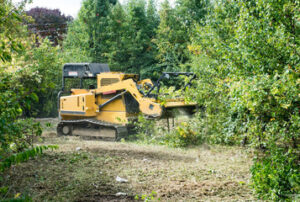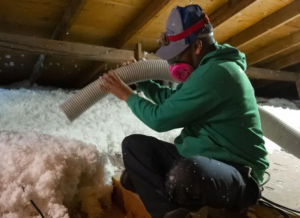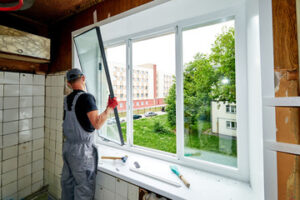Land Clearing is an important part of maintaining property. It helps to reduce fire hazards and creates more accessible spaces. It also helps to promote growth of healthy trees and plants by providing them with access to water and nutrients.

Many jurisdictions require a permit or clearance before land clearing can begin. This process involves submitting detailed information about the project and consulting with stakeholders.
Land Clearing can improve accessibility on construction sites, making it easier for workers and equipment to move around. This can help boost productivity and ensure a safe working environment.
In addition, clearing the site can also enhance the property’s visual appeal. This is important when attempting to attract potential buyers and make a good impression on visitors.
Another benefit of land clearing is that it reduces fire hazards. Combustible debris such as dead trees and brush can pose a serious fire risk, especially in dry climates. Land clearing services can eliminate these risks by removing all flammable materials from the site.
Lastly, land clearing can improve the soil quality by reducing the amount of nutrients that are lost due to overgrowth. It can also promote more uniform growth by redistributing the soil evenly. Moreover, it can help protect against erosion by preventing the buildup of sediment and other unwanted materials in the soil.
The process of land clearing can be complicated and require specialized machinery. This is why it is best to hire a professional. They will have the right equipment to get the job done quickly and efficiently. Professionals will also be aware of any environmental protection laws and regulations, ensuring a smooth and seamless project.
Whether you want to build a house or farm on your property, land clearing can be a great option. It can make the entire area more functional and attractive, allowing you to enjoy all of the benefits of your property to its fullest potential. Additionally, it can increase the value of your home or farm and make it more appealing to potential buyers down the road. Land clearing can also help reduce pests and diseases, as well as make it safer for you and your family to use your property.
Prevents Flooding
In areas prone to flooding and soil erosion, land clearing can help reduce the risk of these issues by removing vegetation that impedes water flow. This process also helps regulate soil health, reducing sedimentation in local water bodies and ensuring that mud and debris aren’t tracked onto public roads during rainy seasons.
Land Clearing can be performed by hand or using specialized machinery. Hand clearing uses hand tools to cut and dig out vegetation, while mechanical clearance involves heavy machinery like bulldozers, backhoes, and chainsaws for quick, thorough removal. Clearing can also be completed chemically, in which case herbicides are applied to the targeted vegetation and then manually or mechanically removed. Clearing can be done by professionals who have a lot of experience and knowledge of various vegetation types, terrains, and weather conditions, so they’re better equipped to handle even the most challenging situations.
Overgrown weeds and dead trees pose a fire hazard, which can quickly spread to surrounding properties during wildfires. Land clearing prevents these risks by removing overgrown vegetation and eliminating tripping hazards caused by fallen limbs. It can also help prevent airborne viruses from spreading from rotting trees, such as mold, to nearby plants, which can cause asthma and other respiratory problems in people.
Properly cleared land improves the aesthetic appeal of residential and commercial properties, and can be used for a variety of purposes, including farming, construction, and landscaping. It can also increase property value, as it makes the land more attractive and appealing to potential buyers and investors. Land clearing can also be a great option for vacant or unused land, as it gives the space more versatility and can increase its market value.
Prevents Erosion
Land clearing removes overgrown trees, shrubs and other vegetation that can easily become tripping hazards. This makes it easier for vehicles and equipment to move around a property, reducing the risk of accidents or injuries. It also prevents pests, like termites, from staying in rotting trees and other debris, by clearing out these areas.
Another important benefit of land clearing is preventing soil erosion. Overgrown vegetation can cause dirt and rocks to move, which can damage surrounding plants, buildings or roads. However, by clearing out the overgrown plants and trees, you can redistribute the soil evenly, reducing the risks of erosion.
If you’re planning to build a home or other structure, it’s essential to clear the land before construction begins. This ensures that the foundation and any other structures will be stable and secure. It also provides a clear space for agriculture and landscaping, making it easier to grow crops and create irrigation systems.
Finally, land clearing can help protect wildlife habitats. Overgrown vegetation can interfere with animals’ ability to find food, water and shelter. However, by performing selective clearing, you can help preserve the biodiversity of your property while still allowing animals to live in healthy habitats.
There are a number of different ways to perform land clearing, including using machinery, manual labor or herbicides. Each method has its own advantages and disadvantages, so it’s important to choose the right one for your project. For example, using machinery can be more expensive but is faster and more effective than manual labor. Herbicides, on the other hand, are effective in killing a wide range of plants but can be harmful to other wildlife and plants.
Prevents Diseases and Pests
Many people are hesitant to undergo Land Clearing due to the negative connotations associated with it, but it’s an important process that provides a variety of benefits. For one, clearing the area helps protect wildlife and provide a space for planting. It also prevents diseases and pests from thriving in overcrowded areas. Furthermore, it allows the soil to regain healthy levels of nutrients, which are important for agricultural use.
There are a variety of different methods for clearing land, including manual and mechanical approaches. Mechanical methods involve the use of bulldozers and other heavy equipment to cut down trees and remove vegetation from the land. This method is often used in the case of large fields that need to be cleared quickly. In contrast, manual clearing involves the use of hand tools to cut down small to medium-sized trees and shrubs. It’s a quick and effective way to clear the land, especially when using a tool like a chainsaw.
Another common approach to clearing land is using controlled burning. This method can be effective for removing unwanted vegetation and is usually done in the fall or spring. However, it’s important to note that this technique can lead to soil erosion and other environmental concerns if not performed correctly.
Another option for clearing land is using biological methods to clear the vegetation. Biological methods typically involve the use of grazing animals to eliminate unwanted vegetation. This approach is environmentally friendly and cost-effective. It also reduces the need for harmful chemical herbicides, which can negatively impact the environment. In addition, the use of grazing animals can help promote biodiversity and increase the overall health of the land.
Promotes a Healthy Environment
Land Clearing is a necessary step in property development, but it also benefits the environment and improves property value. Overgrown vegetation takes up valuable space that could otherwise be used for agricultural activities, and clearing it promotes healthy growth of trees and plants. It also helps prevent soil erosion and flooding by reducing sediment runoff, especially in flood-prone areas.
The soil also loses nutrients over time, and clearing the land allows it to replenish itself with natural plant material. Moreover, when performed properly using eco-friendly methods such as mulching and forest mastication, clearing the land can preserve ecosystems and make it healthier for indigenous species to thrive in the area.
Another benefit of land clearing is that it helps control pests. Dense forests and overgrown properties can be ideal breeding grounds for mosquitoes, gnats, and other pests. In addition, rotting trees provide shelter for termites and other dangerous wildlife like snakes and bears (depending on the region). Land clearing removes these hazards and keeps them away from homes, businesses, and other structures.
Professionals can perform land clearing efficiently and effectively, avoiding potential accidents due to heavy equipment or other risks associated with working on uneven terrains. They can also use specialized machinery to reduce project time and increase the quality of the work done. The experts can also navigate complex legal requirements, such as environmental regulations and zoning laws, to ensure compliance with all applicable guidelines. This minimizes the risk of fines or other penalties if any violation occurs during the project. Land clearing can be a significant investment, so it’s best to seek the help of professionals to avoid costly mistakes that may harm the environment or cause safety hazards for those involved.





